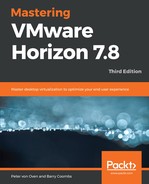In the previous chapter, we introduced you to virtual desktop infrastructure and, in particular, the VMware solution, VMware Horizon. As part of that introduction, we took a high-level view of some of the different components that make up the complete solution. In this chapter, we will start to take a deeper dive into these architecture and infrastructure components, concentrating on how they work together to make up the complete solution.
Throughout the sections of this chapter, we will discuss the role of each of the Horizon View components, explaining where each one fits into the overall infrastructure, and its role. Once we have explained the high-level concept, we will then take a deeper dive into how each individual component works. As we work through the sections, we will also highlight some of the best practices, as well as some useful hints and tips along the way.
Along the way, we will also cover some of the third-party technologies that integrate and complement VMware Horizon, such as antivirus solutions, storage acceleration technologies, and high-end graphics solutions, which all help deliver a complete end-to-end solution from the data center to the end user. After reading this chapter, you will be able to describe each of the Horizon components, such as the following:
- Connection server
- Security server
- Replica server
- Security and the VMware Unified Access Gateway
- Managing end user profiles in View Persona Management (VDI) and User Environment Manager (UEM)
- Display protocols
- Linked, instant, and full clones
- Hardware-accelerated graphics (vSGA, vDGA, and vGPU)
We will discuss what part each one plays within the overall solution, and why you would use them, along with how to configure them and the prerequisites for installation.
